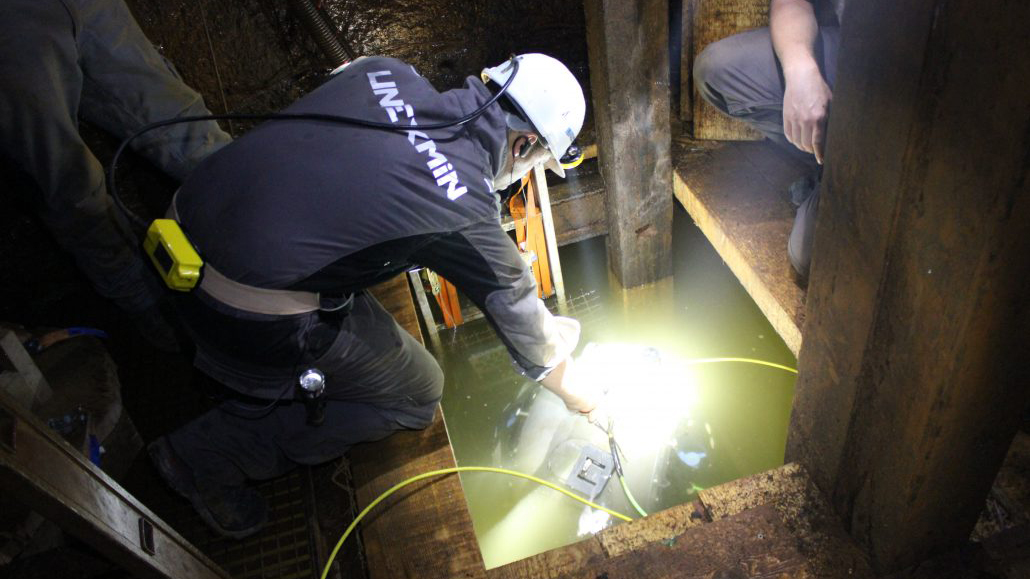Research
Explore cutting-edge Research and Innovation
Science impacts culture, civilisation, technology, and human social, environmental and economic progress. At INESC TEC, we produce science with a real impact on our daily lives. Our scientific research sets the foundations for our mission. Our success and sustainability are an outcome of the quality of our scientific research.
INESC TEC researchers developed an intelligent electric vehicle charger, designed to provide solutions capable of ensuring advanced services to support the distribution network. Know more here.
A comprehensive and inclusive framework of Scientific Domains
To increase INESC TEC impact and improve cohesion among its research groups while facilitating communication with the wider community. These are forums for discussing and planning the Institute’s research trajectory, and platforms for strategising, with medium- to long-term goals.
Scientific domains
Artificial Intelligence
INESC TEC tests Artificial Intelligence to improve investigation competences in environmental crimes. Know more here.
The Artificial Intelligence Scientific Domain is tackling complex challenges in artificial intelligence, focusing on natural language processing, computer vision, deep learning, and AI ethics. The goal of INESCT TEC is to push the boundaries of AI’s capabilities and enhance its integration with human society by pioneering novel applications and technologies.
A primary challenge is developing valuable and reusable AI resources, which involves creating and refining algorithms that can handle diverse inputs and produce models that are accessible and useful across various domains. The team emphasises the importance of data as a crucial asset and the need for effective data management, augmentation, and artificial data creation to overcome data scarcity.
Another notable challenge involves harnessing models and algorithms for complex tasks, creatively utilising pre-trained models, and delving into the possibilities offered by symbolic and neuro-symbolic approaches, with successful implementations showcasing the transformative impact of these strategies. These efforts aim to enhance the predictive capabilities of AI systems and enable their application in new domains.
The Scientific Domain is dedicated to enhancing the transparency and comprehensibility of AI models for humans, through the development of collaborative methods, ensuring the reliability and explainability of AI systems, and
employing visualisation tools that simplify the examination of AI algorithms and models, with documented cases illustrating the benefits of these initiatives. The team also addresses the societal impacts of AI, including privacy and safety.
INESC TEC is exploring data-economic approaches to AI development, recognising the need for new algorithms and frameworks that operate efficiently with less data. The aim is to develop intelligent decision support systems that integrate audio-visual data with other sources to improve the analysis and decision-making process in complex environments.Bioengineering
INESC TEC is part of EBRAINS, a new digital research infrastructure created by the EU-funded Human Brain Project to promote brain research. Know more here.
The Bioengineering Scientific Domain aims to promote scientific knowledge in bioengineering through fundamental and practical research, advanced training, and innovation, such as developing innovative biosensors and novel cancer image analysis approaches. Bioengineering, a rapidly growing and evolving scientific domain at the intersection of engineering and the life sciences, integrates fundamental engineering principles, practices, and technologies in medicine, biology, and environmental and health sciences to provide practical solutions to problems in these fields.
The INESC TEC team concentrates on developing mathematical theories and models, applying physical, biological, and chemical principles, creating computational models and algorithms, and designing devices and systems for applications in clinical, industrial, and educational settings. The team comprises highly multidisciplinary researchers and students with expertise spanning engineering, life sciences, mathematics, and other relevant fields. prioritising the subsequent research challenges:
- Design and development of novel biosensors for macro-to-nano life sciences environments, such as wearables and snap-to-skin biosensing solutions, implantable sensors and actuators/stimulators for adaptative modulation, cell and sub-cell activity sensing in different disease models, or environmental hazardous volatile components.
- Innovative approaches include cancer image analysis, cardiac image and signal analysis, as well as analysis of brain, eye, and lung images, showcasing the team’s diverse contributions to medical imaging.
- Innovative approaches in biorobotics and human-machine symbiosis contribute to the development of surgery, automation in molecular biology, biological-inspired robots and exoskeletons, fusion of robots with humans, ensuring privacy in biometric algorithms, advancing data analysis methods, and designing interpretable representations.
Communications
INESC TEC leads printed electronics project to create 6G antennas. Know more here.
The Communications Scientific Domain is at the forefront of developing cutting-edge wireless communications technologies central to pioneering next-generation communication systems. INESC TEC aims to advance communications research across various sectors, including industry, energy, smart cities, mobility, health, the maritime domain, and agriculture. The team focuses on developing advanced communications solutions that meet the evolving demands of these fields.
The forthcoming wave of mobile and wireless communications will revolutionise the landscape through ubiquitous multimodal sensing and localisation, service-oriented software architectures, the deployment of autonomous systems, including drones and high-altitude platforms, pervasive artificial intelligence, and the integration of edge and cloud computing. These technologies are key to facilitating on-demand virtual and physical networks, thus enabling a seamless, interconnected world.
The team is driven by the dual goals of addressing the need for bandwidth-intensive and latency-sensitive applications and bridging the connectivity gap for the unconnected, whether machines or humans. The primary challenge is the development of communications systems that are inherently context-aware and can be deployed on demand in both terrestrial and non-terrestrial settings. This entails systems capable of dynamically adjusting their operations to suit the communication context, factoring in aspects such as the environment, energy limitations, the entities involved, and the specific requirements of the users or machines.
The team aims to contribute significantly to the research and development landscape in wireless communications, pushing the boundaries of what is currently possible. We anticipate that the work will profoundly influence the creation of innovative solutions essential for the progress of various industries, guaranteeing that communication systems will be more adaptable, efficient, and scalable.Computer Science and Engineering
INESC TEC participates in a project aimed at supporting job search. Know more here.
The Computer Science and Engineering Scientific Domain focuses on addressing the multifaceted challenges of the digital transformation era. Its mission is to address the complexity, scalability, and performance demands of modern computer and software systems, with a focus on ensuring their trustworthiness, security, and sustainability.
The Scientific Domain’s research concentrates on improving the capacity to effectively handle, process, and analyse large amounts of data by leveraging digital sensing, instrumentation, and computing power. Acknowledging the increasing reliance on dependable, efficient, and ethically sound information systems, the team emphasises the need to progress software development ecosystems, ensure software correctness, validation, and testing, and place a fresh focus on ethical issues.
To achieve the necessary scalability, interoperability, and efficiency of critical information systems, the team also recognises the challenges posed by the increasing complexity of computing pipelines, advocating for extensive research in computing architectures and non-functional aspects of software.
A core aspect of the Scientific Domain’s vision is to foster a symbiotic relationship between humans and machines by introducing innovative interaction paradigms like integrated multimodal systems, advanced AI tools, immersive virtual reality experiences, and user-friendly interfaces.
The Scientific Domain’s research and development activities extend across diverse application domains with the goal of advancing technological frontiers and generating socio-economic impact. This involves collaborating on research projects with multiple partners and engaging policymakers to promote the adoption of research outcomes in shaping transformative public policies.
Photonics
INESC TEC developed high-power optic fibre laser to power nano satellites. Know more here.
The Photonics Scientific Domain explores optical phenomena as a unique toolbox for cutting-edge science and technology, exploiting symbiotic S&T for a sustainable research model. Fundamental research, on the one hand, gives rise to novel sensing systems and inventive technology. On the other hand, using emerging technology to enable innovation in real-world applications, materialising the impact of science, and diversifying funding opportunities.
This generic vision is materialised in the research challenges for the next five years:
- Developing small systems for biological and chemical sensing: committing to creating new optical solutions (from transducer mechanisms to signal processing) that can do biochemical sensing without labels or reagents, suitable for biomedical, environmental, and industrial uses that need robust and accurate sensing.
- Photonic sensing for extreme environments: we aim to design light-based sensors that can function in harsh environments such as space and the deep sea. By combining strategies for ultra-high sensitivity, such as the Vernier Effect, and remote sensing, we are committed to developing sensor devices that can assess critical applications in real time and with durability.
- Optical systems and devices for analogue quantum simulations: We will use nonlinear optical systems to build analogue quantum simulators and computing platforms. We are also working on a new way to overcome the problems with von Neumann architectures for quantum simulation and make it easier to connect optical information devices.
In addition to the direct impact on S&T, the team’s R&D activity contributes to the development and training of a new generation of highly specialised human resources with a unique set of competencies and critical knowledge at the national level, positively impacting the organisation while also fostering the emerging industry of photonics (e.g., spin-offs).Power and Energy Systems
One of the demos of the EU-SysFlex project distinguished by “The Global Power & Energy Elites 2020” as one of the most innovative in the “Technology” category. Know more here.
The Power and Energy Systems Scientific Domain envisions supporting society’s full and enduring decarbonisation, adopting a multidisciplinary strategy acting across the whole energy value chain and planning and operating it across multiple energy carriers, infrastructures, and users in an integrated, interconnected, and digitalised energy ecosystem. This will be anchored on combining model-based and data-driven methods for optimising and controlling energy systems while proposing novel policy and regulatory solutions. Research outcomes include concepts, models, methodologies, and tools addressing the decision problems of citizens, communities, multi-utilities, system operators, regulators, policymakers, and government bodies, tackling four major challenges:
- Cost-effective decarbonisation and digitalisation of energy systems: designing and optimising near-100% renewable based energy systems; facilitating secure data sharing in the energy sector (energy data spaces).
- De-centralising energy-driven business models and markets: redesign and regulate wholesale electricity markets to coordinate with local markets, including support mechanisms such as capacity payments.
- Resilience and reliability of energy systems: models and tools for assessing the long-term adequacy of interconnected systems under climate change and power system robustness in converter-dominated grids.
- Smart control architectures and centres of the future: coordinated operation between electricity markets, Transmission System Operators (TSO), and Distribution System Operators (DSO); decentralised protection, automation, and control systems based on virtualisation and distributed computation at the edge; trustworthy AI solutions to support system operations.
A laboratory infrastructure for smart grids and electric vehicles enhances the research and innovation capabilities of the scientific domain by providing technological support for the development and validation of theoretical concepts.Robotics
INESC TEC robots monitor vineyards on the Douro terraces. Know more here.
The Robotics Scientific Domain is at the forefront of developing real multi-domain robotics. It combines intelligence, autonomy, and usefulness seamlessly across various uses on land, in the air, on the water, and underwater. INESC TEC leads the way in developing new and creative scientific methods that connect different areas, resulting in a cohesive foundation for robotic systems.
The focus on advancing autonomy is central, specifically empowering robots to operate effectively in complex and dynamic environments across multiple domains. This involves creating and maintaining intricate environmental maps, reacting swiftly to unforeseen events, and enabling unattended operations over extended periods.
The increasing interaction between people and robots is equally significant in all areas. The team seeks to transform programming and communication interfaces, enhancing the simplicity and availability of assigning tasks to robots for operators from diverse backgrounds. This is essential for smooth and effective collaboration and communication, lowering risks, and enhancing security in various settings.
In each target domain, the team investigates new types of robotic action that go beyond conventional limitations. By doing so, they introduce innovative solutions tailored to the unique challenges of ground, air, water, and undersea applications, enabling them to interface with flexible objects and manipulate objects from moving platforms. This interrelated investigation pushes the limits of conventional applications in each discipline and broadens the scope of what robotics is capable of.
As robotics expands into new fields and operational scenarios, INESC TEC recognises the importance of innovative design methodologies spanning diverse environments. The goal is to streamline the deployment of robotic technologies, guaranteeing the effective and cohesive harnessing of multi-domain robotics’ transformative potential across a wide range of applications.Systems Engineering and Management
The Systems Engineering and Management Scientific Domain addresses the different activities of the systems engineering lifecycle with a focus on four research.
The Systems Engineering and Management Scientific Domain bridges management and engineering to advance the design, implementation, and improvement of systems for decision support, human-centred operations, technology management and innovation. The team addresses the different activities of the systems engineering lifecycle with a focus on four research challenges:
- Understanding the role of businesses and industries in sustainable ecosystem transformation and designing technology-enabled system innovations to facilitate this transformation. How to innovate business models and management practices for sustainability, develop new technology-enabled service solutions and value propositions for ecosystem transformation, and facilitate the adoption and diffusion of their solutions?
- Reducing critical dependencies and weaknesses in current global supply chain models, managing trade-offs, enhancing synergies between sustainability and resilience practices, and using digital technologies for supply chain visibility and joint innovation activities. This area examines how digital technologies help reduce disruptions, enhance supply chain sustainability and resilience, and combine marketing and operations for improved performance.
- Modelling complex relationships among stakeholders with multiple goals, improving decision-making processes in uncertain and dynamic settings, and developing adaptable production systems. This area investigates how to include uncertainty in system modelling, improve decision-making processes, and use hybrid simulation and digital twins for effective operational management.
- Designing systems that foster trust while promoting user adoption and engagement. The main research questions revolve around designing inter-organisational information systems for collaboration and sustainability, managing industrial data to create value, and evaluating the impact of new technologies on organisational capabilities.
Thematic lines
Our activities in the years ahead will be strongly influenced by a set of Transversal Challenges related to expectations from the economy and society that emerge from digital transformation and the associated massive utilisation of digital and digitally-enables technologies. Our four thematic lines are: digital models, sustainable transformation, tackling the extreme and trustworthy technology.
Digital Models

INESC TEC participates in the definition of smart AC strategies for factories. Know more here.
This line aims to bring comprehensive, high-precision digital models of physical entities into the lab, leveraging the groundbreaking strides in pervasive intelligence, a core ethos at INESC TEC. The drive to create more complex digital twins has greatly increased, making it a priority in the EU’s research agenda, with two flagship initiatives focused on developing advanced digital twins of the human brain (EBrains) and the Earth (DestinE).
Future digital twinning platforms will encompass a complete computing pipeline from sensing, edge computing, bigdata management, and processing for monitoring, analysis, training, inference, and forecasting, culminating in visualisation and actuation. A high level of maturity in digital twins leads to a seamless and interactive exchange of information between humans and digital counterparts. This will require cutting-edge technologies like cloud and high-performance computing, pushing the limits of what is possible in terms of scalability, performance, efficiency, reliability, security, and privacy.
Computer Science & Engineering and Artificial Intelligence will focus on the computational challenges of building large-scale, high-fidelity digital twins, including big data management, machine learning, human-computer interaction, information security, and advanced visualisation. The AI researcher’s data-driven and symbolic AI knowledge will make the twins robust and explainable. Communications will enable bandwidth-intensive, latency-sensitive, and secure data transmission.
Robotics will focus on dynamic and autonomous sensing, cyber-physical models and integrating autonomous robots in areas shared with humans. Bioengineering will develop macro to nano biosensors as inputs to biological or “bio-inspired” models, enabling early disease detection, diagnosis, and prediction. Photonics will innovate in real-time nano-scale diagnosis and long-term sensing of extreme environments.
Power & Energy Systems researchers will model and optimise integrated energy systems. In contrast, in Systems Engineering and Management will optimise complex organisations, design customer-centric services, and manage technology-based innovation.
This line presents extensive opportunities to impact INESC TEC’s core innovation areas:
- Industry: Optimising operations, maintenance, and safety;
- Healthcare: Revolutionising patient care through organ/individual simulation and adverse event prediction;
- Environment and Climate: Capturing and predicting weather, climate, ecosystems, and biodiversity for emergency response.
This multidisciplinary thematic line will strategically leverage and integrate INESC TEC’s diverse research capabilities to realise the groundbreaking potential of complex digital models and twins. It calls for further collaborative research to enable more accurate, dynamic digital models that can optimise operations, improve maintenance, enhance safety, revolutionise patient care, and predict and respond to emergencies.Sustainable Transformation

MyNPK is a smart photonics solution that combines spectroscopy and AI to quantify nitrogen, phosphorus, and potassium in liquid fertilisers – in situ and in real time. Know more here.
This thematic research line aims to harness interdisciplinary expertise to address the critical challenge of achieving long-term sustainability in social, economic, and environmental systems. It leverages the collective strengths of INESC TEC’s Scientific Domains to create innovative solutions that balance the intricate interplay of competing objectives within each problem space.
As we navigate the complexities of integrating technology with natural and social systems, this thematic line prioritises the reduction of resource consumption and waste generation through reuse, while exploring sustainable economic models.
Artificial Intelligence and Computer Science & Engineering will develop algorithms and computational models that optimise resource efficiency and reduce environmental impact and can support AI-driven energy and transport management systems.
Bioengineering will contribute by advancing technologies for sustainable healthcare, including the development of biodegradable materials and energy-efficient medical devices. This domain will also explore bioengineering solutions to environmental challenges, such as bioremediation techniques for pollution cleanup.
Communications will work on enhancing the energy efficiency of digital networks, which is crucial for reducing the carbon footprint of our increasingly connected world. This includes the development of low-power communication protocols and the optimisation of data transmission for energy savings.
Photonics will innovate in the development of precision sensing, energy-efficient lighting and photovoltaic technologies, contributing to the reduction of energy consumption and the advancement of renewable energy sources.
Power and Energy Systems will lead efforts in modelling and optimising integrated, sustainable energy systems. Their work will focus on the massive integration of renewable energy sources, energy storage solutions, and the electrification of transport and industry.
Robotics will develop autonomous systems for environmental monitoring and conservation, including robots capable of planting trees, cleaning oceans, and monitoring wildlife. These robots will operate with minimal human intervention, reducing the ecological footprint of conservation efforts.
Systems Engineering and Management will tackle the challenge of designing sustainable business models and optimising complex organisational networks for environmental sustainability. This includes the development of decision-support systems for sustainable supply chain management and the integration of circular economy principles into business practices.
This thematic line strives to foster a collaborative approach among all INESC TEC researchers to enhance and bolster the sustainability of the developed technology by lowering its adoption, maintenance, social, economic and environmental costs.Tackling the Extreme

INESC TEC successfully tests robot to explore flooded mines. Know more here.
This line aims to address the challenges posed by extreme assumptions and design spaces that are increasingly prevalent due to the distributed, intelligent, and autonomous nature of modern digital technologies. This initiative recognises the diverse forms extremes can take, including uncooperative or hostile environments, high-risk activities, instantaneous decision-making requirements, and the handling of massive datasets or entities. A key challenge in these extreme scenarios is the difficulty of conducting proper experimentation and testing, often due to accessibility risks, costs, legal and ethical constraints, or the hypothetical nature of the scenarios.
INESC TEC’s interdisciplinary expertise will develop novel design methods and tools aimed at delivering solutions that are trustworthy, robust, and capable of self-adaptation in the face of extreme conditions. This will involve the use of synthetic modelling techniques and the creation of comprehensive virtual environments to simulate and analyse extreme scenarios safely and effectively.
Computer Science & Engineering and Artificial Intelligence will focus on creating advanced algorithms and computational models capable of operating under extreme conditions. This includes the development of AI systems for rapid decision-making and the analysis of vast datasets.
Communications will concentrate on ensuring reliable and secure data transmission in extreme environments, developing technologies that can withstand interference, disruptions, and high-risk conditions, thereby maintaining the integrity and availability of critical communications.
Photonics will develop sensors and imaging technologies capable of operating in extreme conditions, such as high temperatures, pressures, or radiation levels, enabling the observation and analysis of otherwise inaccessible or hazardous environments.
Robotics will focus on designing and deploying autonomous systems capable of navigating and performing tasks in dangerous or uncooperative environments, from deep-sea exploration to disaster response, minimising human exposure to risk. Similarly, Bioengineering will explore the development of resilient biotechnologies for human monitoring extreme conditions, as well as bio-sensing techniques that can operate in hostile or contaminated environments, contributing to environmental monitoring and cleanup efforts.
Power & Energy Systems will address the challenges of energy management and distribution in extreme scenarios, focusing on developing resilient and adaptive energy systems that can ensure continuous operation under adverse conditions.
Systems Engineering and Management will tackle developing decision-support tools and methodologies for planning and executing high-risk and high-stakes activities.
Through this initiative, INESC TEC reaffirms its commitment to pushing the boundaries of innovation, contributing to a future where extreme environments are no longer barriers to exploration, discovery, and progress.Trustworthy Technology

INESC TEC develops technology for real-time triage of victims in disaster situations. Know more here.
This line aims to develop reliable, secure, and ethical digital technologies integral to modern society. This multidisciplinary strand leverages expertise from the eight INESC TEC Scientific Domains to address the challenges of creating technology that is not only advanced but also dependable and aligned with societal and environmental values.
As the world faces pressing challenges such as climate change, inequality, and geopolitical instability, trustworthy technology will become increasingly important in supporting sustainable and resilient societies. Transparency, equity, reliability, security, privacy, and meaningful human control need to be at the forefront of research and development in the upcoming years as our dependence on cutting-edge technologies increases.
Artificial Intelligence and Bioengineering will develop explainable AI models, ensuring fairness in algorithmic decision-making, enhancing robustness against biased or unethical outcomes, and, chiefly, for healthcare, developing transparent and replicable machine learning models for patient benefit.
Computer Science and Engineering will lead the research on the dependability-, security-, and privacy-enabled technologies orchestrating the various Scientific Domains concerns and expertise, notably on large-scale data-centric systems, towards robust digital and cyber-physical real-world solutions. Communications and Photonics will work on secure data transmission, protecting sensitive information, and defending against adversarial attacks.
Robotics and Computer Science & Engineering will explore human-computer interaction, designing intuitive and trustworthy communication channels for seamless collaboration between humans and autonomous systems.
Power & Energy Systems will leverage its expertise and long-standing experience in developing secure and efficient power grids to ensure data integrity and trustworthiness in decentralised autonomous system operations, as well as to promote cross-disciplinary translational research into related critical infrastructures.
Systems Engineering and Management will optimise complex organisations and networks, ensuring customer-centric service design, and managing technology-based innovation.
By encouraging collaboration among these diverse research groups, the thematic research line will create synergies that drive innovation in trustworthy technology. This multidisciplinary approach will enable the development of comprehensive solutions that address the technical, ethical, and societal challenges associated with the increasing reliance on digital systems.
The research line will also prioritise disseminating knowledge and best practices, engaging with stakeholders across academia, industry, and government to promote adopting trustworthy technology. Through this collaborative effort, the thematic research line aims to contribute to a future where digital systems are reliable, secure, and aligned with the values and needs of the communities they serve.



